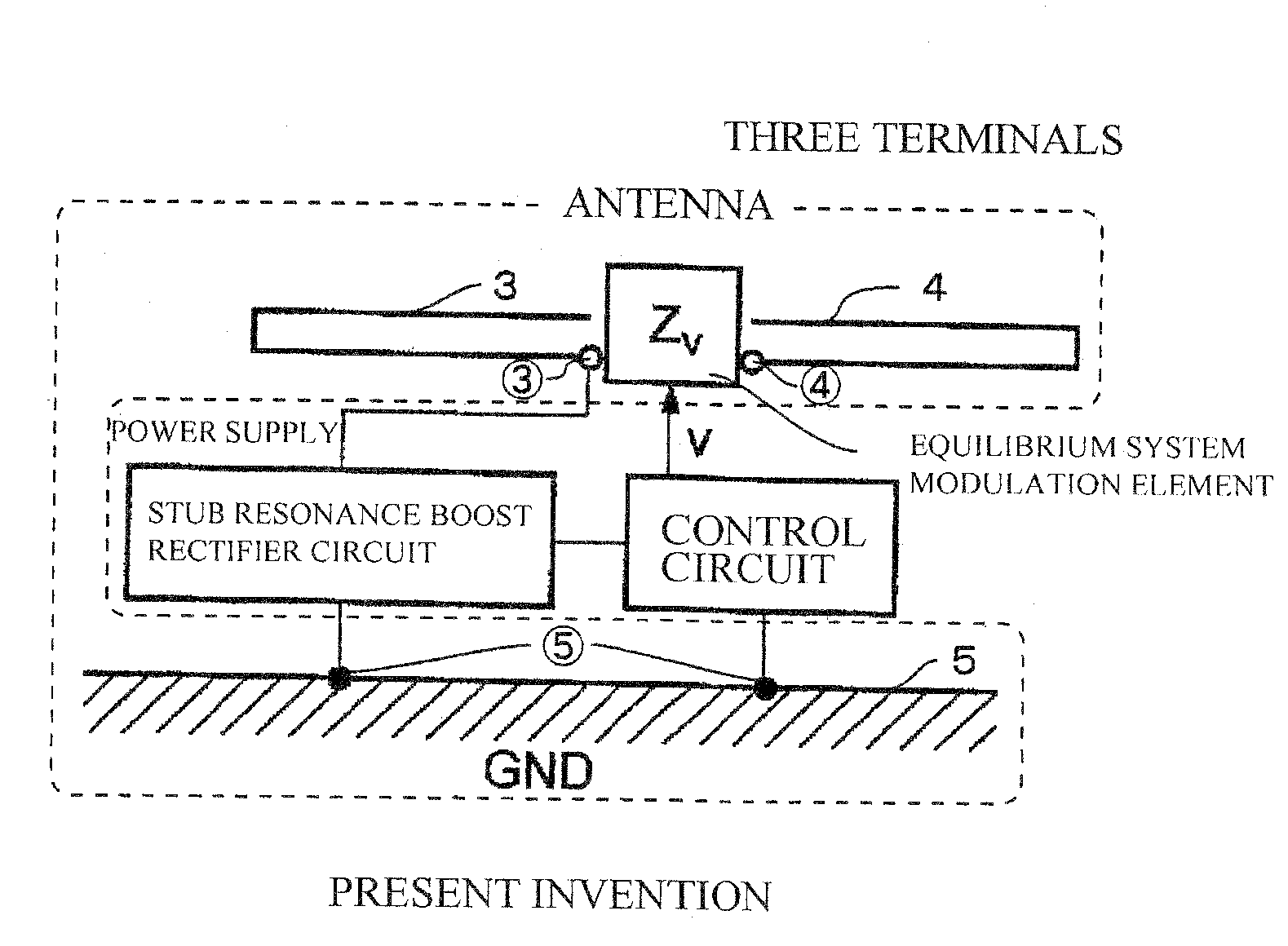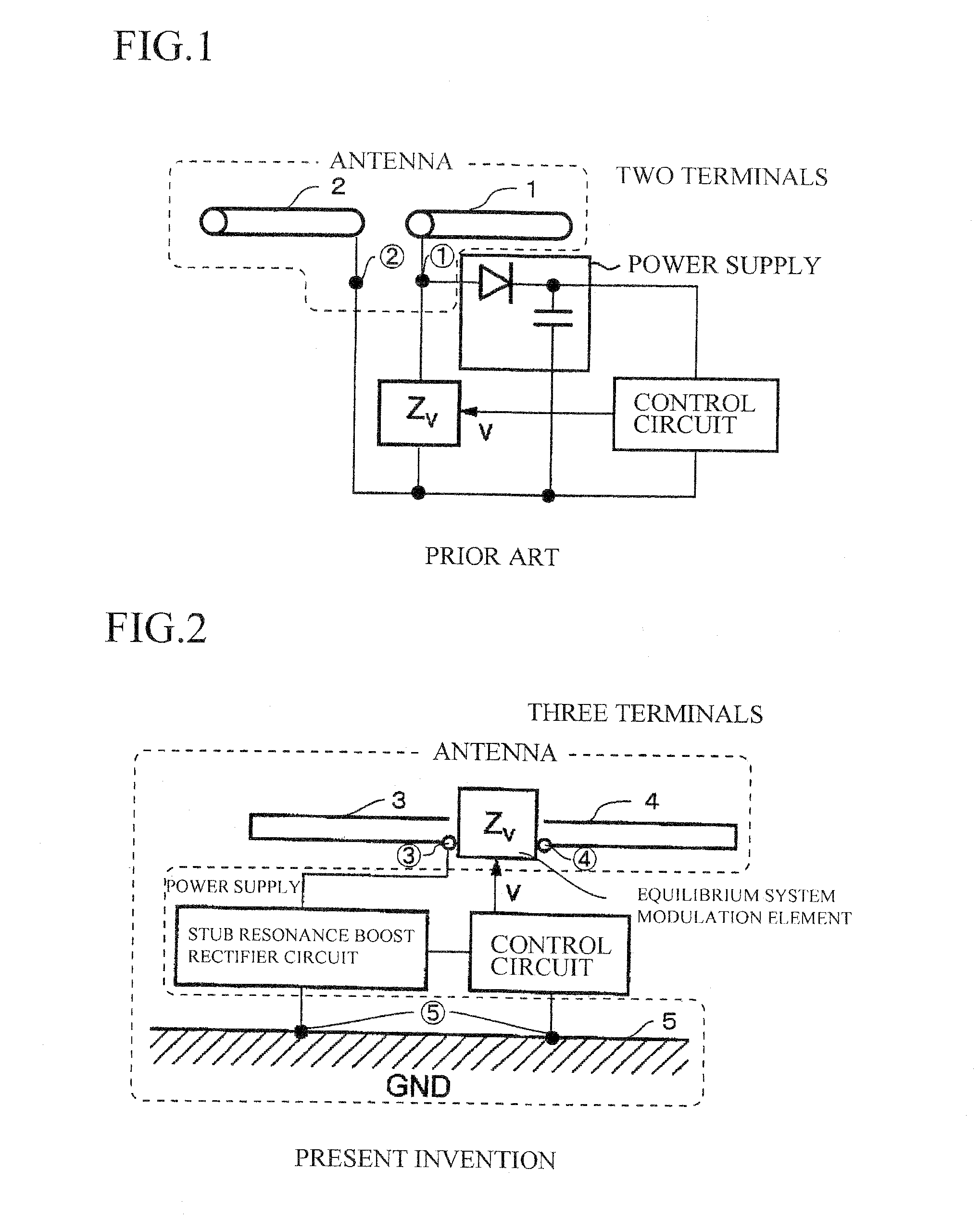Rf ID Tag Device
a technology of rfid tag and position detection, applied in the direction of reradiation, instruments, near-field systems using receivers, etc., can solve the problems of low transmission output (conversion efficiency), considerable loss of received power, and short communication range, so as to maximize the reception efficiency of an antenna
- Summary
- Abstract
- Description
- Claims
- Application Information
AI Technical Summary
Benefits of technology
Problems solved by technology
Method used
Image
Examples
example 1
[0095]FIG. 3 illustrates the basic configuration of an RFID tag device of the present invention. In this figure, the antenna of the RFID tag device includes a ground plane conductor, an insulating layer and a divided strip conductor. The RFID tag device shown in this figure is for use in the 2.45 GHz band, and all specified dimensions are in units of mm. Also, the dividing point of the divided strip conductor is deviated slightly more than equal division in the longitudinal direction, and this feature achieves the effect of improving the reception efficiency of the antenna.
[0096]FIG. 4 illustrates the details of the control circuit chip shown in FIG. 3 and connections between the divided strip conductor and the control circuit.
[0097]In FIG. 4, the control circuit chip and the antenna are connected at six points A, B, C, D, E and F. PIN diodes D7 and D8 for impedance modulation are connected between A and B and between D and E, respectively, and a feeding point of the antenna lies be...
example 2
[0113](A method for detecting the position of a moving object without an RFID tag)
[0114]The feature of the RFID tag of the present invention that is capable of relatively long range communication in spite of having no power supply is utilized.
[0115]Assuming that the positions of tags #1 through #4 and interrogators #1 and #2 are known as shown in FIG. 6, it is possible to estimate the position of a mobile object based on information concerning paths obstructed by the moving object.
[0116]In this case, a system may be configured such that fm1=fm2, fs1=fs2=fs3=fs4, the interrogators provide CW outputs in a time-division system, and the tags respond by an anticollision method.
[0117]Further, a system may be configured such that fm1≢fm2, fs1=fs2=fs3=fs4, the interrogators successively provide CW outputs, and the tags respond by an anticollision method.
[0118]Furthermore, a system may be configured such that fm1≢fm2, fs1, fs2, fs3 and fs4 are all different frequencies, and the interrogators...
example 3
[0119](A method for detecting the position of a moving object with RFID)
[0120]The feature of the RFID tag of the present invention that is capable of relatively long range communication in spite of having no power supply is utilized.
[0121]As shown in FIGS. 22 and 23, a plurality of receiving antennas are used at the master device, and CW signals are transmitted at two or more frequencies to detect differences in phase between response signals from RFID tags, making it possible to estimate three-dimensional locations of the RFID tags.
[0122]FIG. 7 illustrates the configuration of a master device. A Fourier transform section performs time-series Fourier integration on Re and Im data of antennas #1 through #4 to calculate a spectrum phase at a frequency Δ. In this case, it is assumed that phase differences due to each antenna cable and down converter and a time delay in operations of a selecting switch are calibrated for the compensation.
[0123]Note that FIGS. 29 to 31 present an example...
PUM
 Login to View More
Login to View More Abstract
Description
Claims
Application Information
 Login to View More
Login to View More - R&D
- Intellectual Property
- Life Sciences
- Materials
- Tech Scout
- Unparalleled Data Quality
- Higher Quality Content
- 60% Fewer Hallucinations
Browse by: Latest US Patents, China's latest patents, Technical Efficacy Thesaurus, Application Domain, Technology Topic, Popular Technical Reports.
© 2025 PatSnap. All rights reserved.Legal|Privacy policy|Modern Slavery Act Transparency Statement|Sitemap|About US| Contact US: help@patsnap.com



